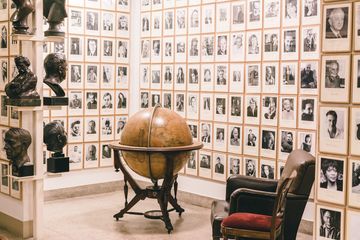Tucked away on an upper floor of the Church of the Intercession sits the office of Mano a Mano: Mexican Culture Without Borders. The space is a riot of color: paintings hang on the wall, piñatas and cut-out streamers dangle from the ceiling, and shelves of ceramics, jewelry, and embroidered cloth line the room. In the far corner, a man sits at a desk painting a vase with meticulous strokes. Juan Aguirre, executive director of Mano a Mano, informed me that the artist was inspired by the floral pattern traditionally used in embroidery - by painting instead of sewing, the artist was putting his own twist on the tradition.
Juan’s passion for Mexican culture and art is palpable. Our conversation covered everything from the history and significance of depictions of Our Lady of Guadalupe (she is at once a religious, national, and artistic symbol) to the indigenous and African roots of Veracruz’s Son Jarocho music to the demographics of New York’s Mexican community. “Mexico, when you think about it, it’s really a little world in itself,” Juan explained. “It’s dance. It’s music. It’s being creative with your hands.”
Perhaps unsurprisingly, the word “tradition” came up frequently as we talked. According to their website, Mano a Mano is a nonprofit organization “dedicating to celebrating Mexican culture and promoting the understanding of Mexican traditions through arts, culture, humanities and annual celebrations of holidays.” But what counts as tradition? “A lot of Mexican culture is sort of like a "synchretism." It’s two things that came together. So we have native ideals and European ideals that merged into one and produced a new thinking, a new way of looking at the world,” Juan told me. “For us, ‘traditional’ means anything older - something that goes back fifty years or beyond and that is passed on from generation to generation. It’s what we call folk.”
Mano a Mano’s work is divided into three main sectors: public events, educational programming, and support for artists of Mexican origin. All of Mano a Mano’s programming is completely bilingual in English and Spanish, so as to be as inclusive as possible. Their public events consist largely of celebrations of Mexican holidays, including Children’s Day, Día de los Muertos/Day of the Dead, Independence Day, Cinco de Mayo, and Posadas/Christmas. The events take place at various locations around the city and attract large crowds of Mexicans and non-Mexicans alike. For their “Mexico in New York” programs, Mano a Mano visits schools, senior centers, and other nonprofits where they put on performances, workshops, and talks aimed at sharing Mexican culture. The organization also acts as a knowledge center for artists by connecting them with various grants and opportunities. In addition, Mano a Mano often provides interpretation services in legal or health matters for Mexicans in the city who speak one of Mexico’s indigenous languages and little to no Spanish or English.
The organization started in 2001, when a committee on Mexican artists was founded at the Center for Traditional Music and Dance. Though Mexicans now make up the third largest Hispanic group in New York, this is a fairly recent development. In the early aughts, the Mexican population in New York was growing quickly, and, although there were many organizations dedicated to helping this budding community, the committee members recognized a need for one that provided support specifically for Mexican arts. In 2006, the committee became a nonprofit in its own right, and Mano a Mano was born.
For his part, Juan joined Mano a Mano in 2011. “When I was growing up in New York, this wasn’t available,” he said, gesturing at the room. “I remember how difficult it was trying to relate to other people. Mexican culture and Mexican arts are ingrained in us growing up. They are a central part of our traditions and our way of living. It was important for me to show the richness of the culture to people who are of Mexican origin and to those who are not. I think that the more people discover the history and the culture of Mexico, they fall in love with it. They understand it and they want to be part of it.”

